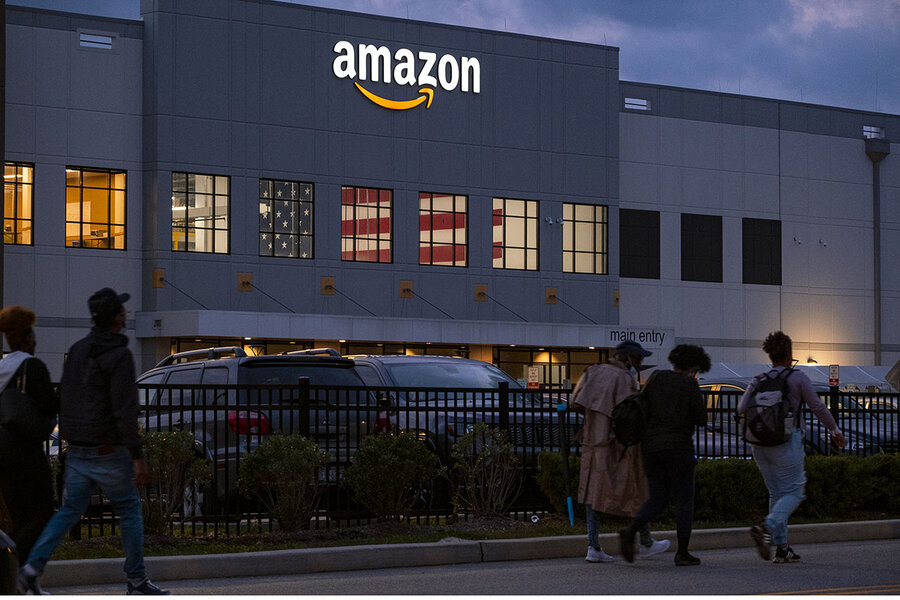Independent unions are having a moment. But are they here to stay?
When workers at an Amazon warehouse in Staten Island voted to unionize in April, it kicked off an exciting summer for pro-union activists. New unions are popping up in stores of big national brands from Apple, to Starbucks, to Trader Joe’s, and now even Lululemon.
But the win at that Amazon warehouse was the most eye-catching, and the least expected. The union, which called itself Amazon Labor Union (ALU), was new – founded in 2019 – and independent. It had no formal ties to well-established unions like the Teamsters or the Retail, Wholesale and Department Store Union that had spent years and millions of dollars trying to organize Amazon workers.
“No one thought they had a chance of winning,” says John Logan, a professor of labor and employment studies at San Francisco State University. “No one had ever heard of the Amazon Labor Union.”
Now, however, the ALU is the hottest news in the labor movement. Its success is inspiring others to follow its footsteps and take the same, independent route. But sustaining that success may require cooperation with the organizations they eschew.
What is an independent union?
An independent union is a union that has no official affiliation with larger organizations like the United Auto Workers or the Teamsters. Most unions fit into a huge hierarchy. Workers at a grocery store might belong to a local branch of the United Food and Commercial Workers, which in turn is part of the AFL-CIO, one of two federations that, together, represent nearly all of America’s union workers.
Independent unions don’t fit into those hierarchies. They’re on their own. They tend to represent workers in one specific industry or even a single workplace, but apart from being unaffiliated, they function just like any other union.
What are the drawbacks to independent unions?
The main downside is that independent unions typically don’t have the same resources or clout as more established unions. Patricia Campos-Medina, executive director of The Worker Institute at Cornell University’s labor relations school, says large, affiliated unions “have organized legal departments, well-organized communications departments, relationships with elected officials to drive policy,” and, of course, deep pockets.
By contrast, ALU crowdsourced about $120,000 and got pro bono help from labor lawyers and veteran union organizers. That’s not much to go on compared with the coffers of long-standing unions, or the roughly $4.3 million that Amazon reported spending on anti-union efforts in 2021.
On the other hand, independent outfits have an advantage in credibility. Independent organizers bring intimate knowledge of their workplace that lets them craft tailored ideas for improving it. When big unions want to unionize a workplace, they often show up as outsiders. Dr. Logan says companies often tell their employees that a union is an external force that “doesn’t really either understand or even necessarily care about the things that are your concerns with the workplace.”
Chris Smalls, one of ALU’s leaders, has said that that kind of unfamiliarity was one reason a long-standing union’s recent effort to organize an Alabama Amazon warehouse has failed so far.
ALU’s credibility has won over another Amazon facility, near Albany, New York, where would-be union members have chosen to organize with the fledgling ALU.
Trader Joe’s employees in Hadley, Massachusetts, who just formed an independent union of their own, voiced the same eagerness for autonomy, saying they didn’t want just another “boilerplate” contract. On Aug. 12, a Minnesota store voted to follow them into the union, 55-5.
What’s next and what does this mean for the overall labor movement?
There have been bursts of grassroots organizing before, but they haven’t reversed the steady decline in unions’ membership and power in the United States.
“With this newfound energy and creativity and interest and support, [grassroots unions] stand a chance of really getting things going,” says Jon Hiatt, who served as the AFL-CIO’s chief legal counsel and still works in labor law. “But I think there’s a real chance it’s going to die out if organized labor doesn’t bring the institutional support that is going to be necessary to keep it going.”
Evolution might look like what’s happening with Starbucks. Workers at over 200 of the coffee shops have been unionizing with the same kind of grassroots passion shown by ALU, but their union, Starbucks Workers United, has official backing from Workers United, which itself is linked to the huge Service Employees International Union.
The future of labor movements may very well depend on similar cooperation. Grassroots organizers are “forcing international unions to learn to be more nimble and actually not make all the decisions at the top,” says Dr. Campos-Medina. “[Established unions] need to give local leaders a bit more room to be creative.”






